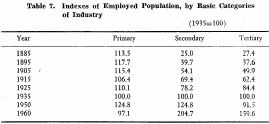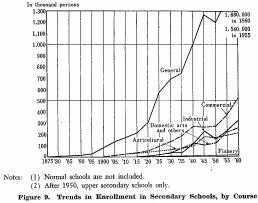| Home > Policy > White Paper, Notice, Announcement > White Paper > JAPAN'S GROWTH AND EDUCATION 1963 > CHAPTER |
||
Trends in secondary school enrollment by major field of study are indicative of socio-economic change.
Comparison of enrollments in general courses and in vocational courses of secondary schools shows that the percentage of total enrollment found in the former has decreased from 84.7 per cent in 1895, to 67.7 per cent in 1920, 63.0 per cent in 1935 and 58.3 per cent in 1960. However, more than half of the total enrollment in secondary schools is still in the general courses, despite continuous increases in the percentage of the total enrollment found in vocational courses since the Meiji Era. Each of the types of courses has been so closely related to the socio-economic developments that each has been changing constantly in response to the changes in the various phases of industry. Indexes of total employed 'population in each of the basic categories of industry-primary, secondary and tertiary -since the Meiji Era are shown in Table 7, with the year 1935 taken as the base year.

The population employed in primary industries increased up to 1895 with subsequent decreases each decade except in 1950. The population employed in secondary industries started from the lowest percentage and increased continuously each decade from 1885 to 1960. The tertiary industry population showed a very similar trend except during 1950.
Figure 9 shows the trends in the total enrollments in institutions of secondary education by major field of study. The enrollment in industrial courses increased by 6.7 times between 1935 and 1960 in correspondence to the increase in the industrial population. Particularly notable was the increase between 1935 and 1945 when the Japanese society shifted from quasi-war to wartime footing. The overall industrial production index also went rapidly until the end of the War in 1945.

The enrollment in commercial courses increased steadily up to 1940. Subsequently, however, it decreased gradually under the war-time mobilization for increased production. It was only after the War that the enrollment began to increase again, corresponding to the rapid increase in the population engaged in tertiary sales, distribution and service industries.
The population engaged in primary industries, i.e., agriculture, fishing, mining, etc., is decreasing gradually. However, thee rate of the post-war increase in the enrollment in the fisheries course is rather high, even though the actual number of students is small. The enrollment in the agricultural course, too, has not decreased since the Meiji Era. Agricultural schools have contributed to the spread of secondary education in agricultural districts not only by giving education in agricultural techniques but also by serving as institution of general secondary education in these districts. The recent increase in the enrollments in both agricultural and fisheries courses has been a response to a definite economic need for improving techniques and methods in agriculture and fishing.
| Back to Top | MEXT HOME |